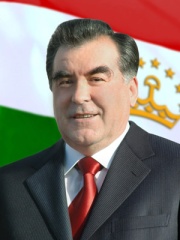

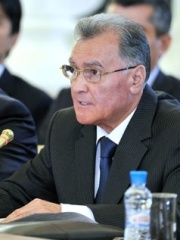
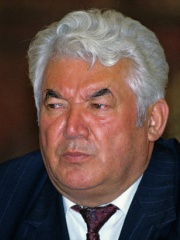
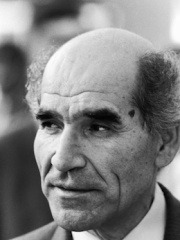
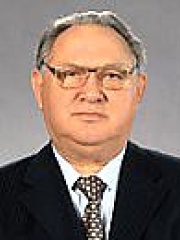
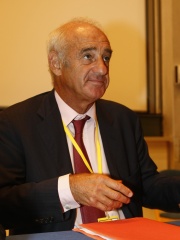
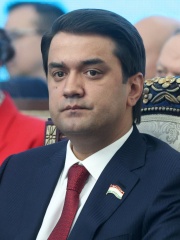
The Most Famous
POLITICIANS from Tajikistan
This page contains a list of the greatest Tadzhik Politicians. The pantheon dataset contains 19,576 Politicians, 9 of which were born in Tajikistan. This makes Tajikistan the birth place of the 157th most number of Politicians behind Tonga, and Kosovo.
Top 9
The following people are considered by Pantheon to be the most legendary Tadzhik Politicians of all time. This list of famous Tadzhik Politicians is sorted by HPI (Historical Popularity Index), a metric that aggregates information on a biography's online popularity.

1. Emomali Rahmon (b. 1952)
With an HPI of 73.62, Emomali Rahmon is the most famous Tadzhik Politician. His biography has been translated into 81 different languages on wikipedia.
Emomali Rahmon (born Emomali Sharipovich Rahmonov; 5 October 1952) is a Tajikistani politician who has served as the third president of Tajikistan since 1994, having previously led the country as Chairman of the Supreme Assembly from 1992 to 1994. Since 1998, he has also served as the leader of the People's Democratic Party of Tajikistan, which dominates the Parliament of Tajikistan. On 30 September 1999, he was elected vice-president of the United Nations General Assembly for a one-year term. He became better known in 1992 after the abolition of the presidency, when at the dawn of the civil war he became Chairman of the Supreme Soviet (Parliament) of Tajikistan as a compromise candidate between communists and neo-communists on the one hand and liberal-democratic, nationalist and Islamist forces (the United Tajik Opposition) on the other. Rahmon has won five undemocratic presidential elections. In addition, he extended his powers via constitutional referendums in 1999 and 2003. Following the results of another constitutional referendum in 2016, amendments were adopted that removed presidential term limits. Rahmon heads an authoritarian government in Tajikistan. Political opponents are repressed, violations of human rights and freedoms are severe, elections are not free and fair, and corruption and nepotism are rampant. Various important government positions are occupied by his family members, such as his 37-year-old son Rustam Emomali, who is the chairman of the country's parliament and the mayor of its capital city, Dushanbe.

2. Spitamenes (400 BC - 328 BC)
With an HPI of 68.73, Spitamenes is the 2nd most famous Tadzhik Politician. His biography has been translated into 26 different languages.
Spitamenes (Old Persian Spitamana; Greek Σπιταμένης; 370 BC – 328 BC) was a Sogdian warlord and the leader of the uprising in Sogdiana and Bactria against Alexander the Great, King of Macedon, in 329 BC. He has been credited by modern historians as one of the most tenacious adversaries of Alexander.

3. Oqil Oqilov (b. 1944)
With an HPI of 65.39, Oqil Oqilov is the 3rd most famous Tadzhik Politician. His biography has been translated into 37 different languages.
Oqil Ghaybulloyevich Oqilov (born 2 February 1944), alternatively transliterated as Akil Akilov, is a Tajikistani politician who served as the 7th prime minister of Tajikistan from 20 December 1999 to 23 November 2013. He is a member of the People's Democratic Party of Tajikistan.

4. Rahmon Nabiyev (1930 - 1993)
With an HPI of 65.07, Rahmon Nabiyev is the 4th most famous Tadzhik Politician. His biography has been translated into 33 different languages.
Rahmon Nabiyevich Nabiyev (5 October 1930 – 11 April 1993) was a Tajik politician who served as the second president of Tajikistan from 1991 until his resignation in 1992. Having previously served in this role briefly for 13 days from September to October 1991, Nabiyev was the shortest-serving president in Tajik history and was also the first directly elected Tajik president. Born in Khujand, Nabiyev started working as an accountant on a collective farm at the age of 16 in 1946. In the same year he entered the Leninabad Agricultural College (now Agricultural University of Tajikistan) and graduated in 1949. In 1954, he began to work for two years as the chief engineer of the machine-tractor station in Isfisor. In 1961, Nabiyev joined politics and became the Minister of Agriculture in 1971, serving in this role until in 1973 where he became the chairman of the Council of Ministers (head of government). Aged 43 upon assuming office, Nabiyev was the youngest Tajik head of government ever. In 1982, Nabiyev became the first secretary of the Communist Party of Tajikistan and thus the de facto leader of Tajikistan. He served in this role until in 1985 where he was ousted in a corruption scandal. In September 1991 shortly after independence, Nabiyev became the chairman of the Supreme Soviet of Tajikistan and thus the president of Tajikistan. However, he stepped down 13 days later in early October following intense pressure to do so. Nabiyev participated in the subsequent presidential elections held the following month and was elected president despite accusations of fraud by opponents and was eventually sworn in on 2 December. Nabiyev's presidency was marked by intense political instability, economic hardship, and discontent against his rule. In March 1992, a group of protests were formed against Nabiyev and his government which started the Tajikistani Revolution, demanding democratic reforms. However, the protesters were suppressed and thus the protests escalated into a civil war on 5 May. Four months later on 7 September, Nabiyev was ambushed and held at gunpoint where he was forced to resign under pressure and did so on Dushanbe Airport. His resignation was officially accepted on 19 November during the 16th session of the Tajik Supreme Soviet which abolished the presidency. On 11 April 1993, Nabiyev died under mysterious circumstances. While the official cause of death was a heart attack, there were other rumours stating that Nabiyev was either murdered or committed suicide. His family however, denied that Nabiyev died of a heart attack stating that he had no heart problems and instead believed that he was killed by pro-government forces. While Nabiyev's legacy is often overshadowed by Emomali Rahmon, his successor and the current president of Tajikistan, Nabiyev was remembered for playing a major role in the early history of Tajikistan while criticised for starting a civil war which killed up to 150,000 people.
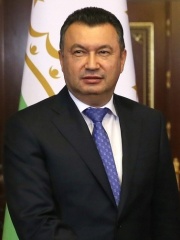
5. Kokhir Rasulzoda (b. 1959)
With an HPI of 62.32, Kokhir Rasulzoda is the 5th most famous Tadzhik Politician. His biography has been translated into 37 different languages.
Qohir Rasulzoda (born Abduqohir Abdurasulovich Nazirov, 8 March 1961) is a Tajikistani politician who is serving as the Prime Minister of Tajikistan since 23 November 2013. He is a member of the People's Democratic Party of Tajikistan. The Prime Minister post in Tajikistan is largely ceremonial. Power is concentrated in the hands of authoritarian ruler, President Emomali Rahmon.

6. Qahhor Mahkamov (1932 - 2016)
With an HPI of 62.24, Qahhor Mahkamov is the 6th most famous Tadzhik Politician. His biography has been translated into 26 different languages.
Qahhor Mahkamov (Russian: Кахар Махкамович Махкамов, romanized: Kakhar Makhkamovich Makhkamov, Tajik: Қаҳҳор Маҳкамов; alternative spelling Kahar Mahkamov; 16 April 1932 – 8 June 2016) was a Tajik politician who served as First Secretary of the Communist Party of Tajikistan from 1985 to 1991 and was the first President of Tajikistan from November 1990 until his fall in the August 1991 coup.

7. Yuri Maslyukov (1937 - 2010)
With an HPI of 54.37, Yuri Maslyukov is the 7th most famous Tadzhik Politician. His biography has been translated into 17 different languages.
Yury Dmitriyevich Maslyukov (30 September 1937 – 1 April 2010) was a Soviet and Russian politician who was in charge of the Gosplan for three years preceding the demise of the Soviet Union and first deputy prime minister in 1998–1999.

8. Henri Weber (1944 - 2020)
With an HPI of 52.48, Henri Weber is the 8th most famous Tadzhik Politician. His biography has been translated into 16 different languages.
Henri Weber (23 June 1944 – 26 April 2020) was a French politician and Member of the European Parliament for the north-west of France. He was a member of the Socialist Party (PS), which is part of the Party of European Socialists, and sat on the European Parliament's Committee on Culture and Education.

9. Rustam Emomali (b. 1987)
With an HPI of 42.23, Rustam Emomali is the 9th most famous Tadzhik Politician. His biography has been translated into 19 different languages.
Rustam Emomali (born Rustam Emomalievich Rahmonov; 19 December 1987) is a Tajik politician who is the current Chairman of the National Assembly of Tajikistan, Mayor of Dushanbe and the eldest son of Emomali Rahmon, the long-standing president of Tajikistan. Rustam Emomali is believed to be prepared by his father to succeed him as the leader of Tajikistan; he holds the title of the constitutionally designated successor to the presidency. He heads the anti-corruption agency in Tajikistan and the state's financial oversight agency. Despite not having served in the armed forces, he holds the rank of major general. He was appointed as the mayor of Dushanbe by his father in 2017 at the age of 29.
People
Pantheon has 9 people classified as Tadzhik politicians born between 400 BC and 1987. Of these 9, 4 (44.44%) of them are still alive today. The most famous living Tadzhik politicians include Emomali Rahmon, Oqil Oqilov, and Kokhir Rasulzoda. The most famous deceased Tadzhik politicians include Spitamenes, Rahmon Nabiyev, and Qahhor Mahkamov.
Living Tadzhik Politicians
Go to all RankingsEmomali Rahmon
1952 - Present
HPI: 73.62
Oqil Oqilov
1944 - Present
HPI: 65.39
Kokhir Rasulzoda
1959 - Present
HPI: 62.32
Rustam Emomali
1987 - Present
HPI: 42.23
Deceased Tadzhik Politicians
Go to all RankingsSpitamenes
400 BC - 328 BC
HPI: 68.73
Rahmon Nabiyev
1930 - 1993
HPI: 65.07
Qahhor Mahkamov
1932 - 2016
HPI: 62.24
Yuri Maslyukov
1937 - 2010
HPI: 54.37
Henri Weber
1944 - 2020
HPI: 52.48
Overlapping Lives
Which Politicians were alive at the same time? This visualization shows the lifespans of the 4 most globally memorable Politicians since 1700.

